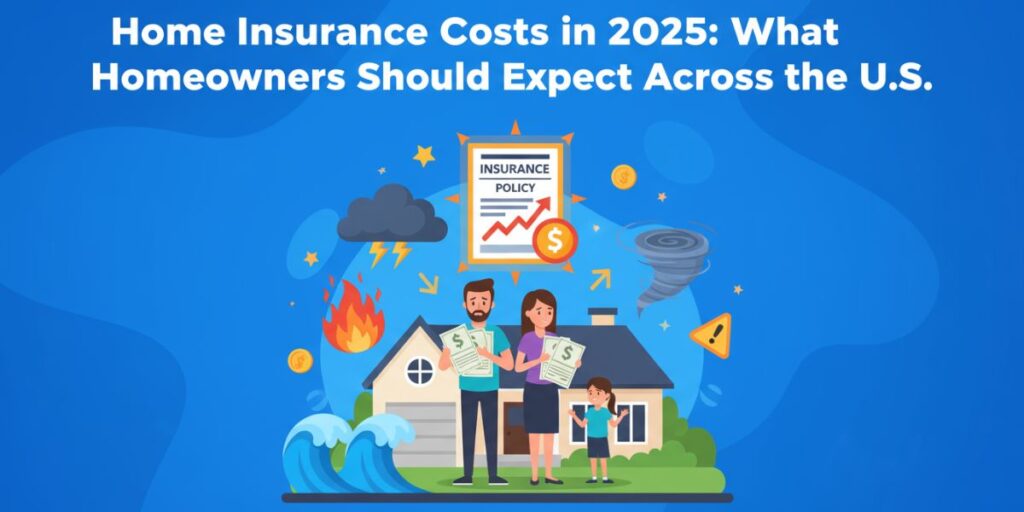Home insurance is becoming one of the fastest-growing expenses for American households. As climate change fuels more destructive storms, floods, and wildfires, insurers are raising rates, cutting coverage, or leaving entire regions.
For many families, the result is a painful choice: pay higher premiums, accept less protection, or risk going without insurance altogether.
Why Premiums Keep Rising
Over the past five years, insurers have faced record-breaking payouts from hurricanes in the Southeast, wildfires in the West, and flooding in coastal and inland states.
According to a National Bureau of Economic Research study, home insurance premiums rose by 30% between 2020 and 2023, and experts warn the trend will continue. Insurers say they’re struggling to balance risk with affordability.
When losses exceed projections, they either raise rates or pull out of high-risk regions entirely. That leaves state-run “insurers of last resort” to step in—often with higher prices and fewer benefits.
State-by-State Outlook for 2025
In California, wildfires remain the biggest threat. State Farm and Allstate have already stopped writing new policies in many areas, with premiums jumping nearly 20% in 2023 and more hikes expected in 2025, especially in wildfire zones.
Florida continues to grapple with devastating hurricane seasons. More than a dozen insurers have gone bankrupt or withdrawn from the market, forcing 1.3 million homeowners into Citizens, the state’s last-resort insurer.
Premiums there could rise another 15–25% in 2025. In Texas, where hurricanes, hailstorms, and floods drive some of the highest storm-related claims in the nation, premiums rose about 16% in 2023 and are expected to climb 10–15% this year, particularly along the Gulf Coast.
Louisiana is facing similar struggles, with homeowners seeing 20% or greater increases and fewer private options after several storms pushed carriers out of the state.
The Northeast is not immune. In New York and New Jersey, premiums are rising 5–10% due to storm and flood risks, especially in coastal areas. The Midwest, including states like Illinois, Iowa, and Missouri, is seeing moderate increases of 5–8% linked to tornadoes and flooding.
Colorado homeowners are facing premium hikes of 10–15% due to wildfire and hail threats, especially in mountain and Front Range communities. Even states with fewer disasters are affected by inflation, labor shortages, and reinsurance costs, with average homeowners nationwide likely to face 5–12% increases in 2025.
State-by-State Outlook for 2025
Here are projected premium increases for 2025 in some of the most affected states:
| State/Region | Main Risk(s) | 2025 Premium Outlook | Notes |
|---|---|---|---|
| California | Wildfires | +10–20% | Nonrenewals in high-risk zones; insurers exiting markets |
| Florida | Hurricanes | +15–25% | Citizens insurer of last resort expanding rapidly |
| Texas | Hurricanes, hail, floods | +10–15% | Strongest increases along Gulf Coast |
| Louisiana | Hurricanes, flooding | +20%+ | Shrinking private coverage, reliance on state insurer |
| New York & NJ | Coastal storms, floods | +5–10% | Strong regulation slows rate hikes, but risks remain |
| Midwest (IL, IA, MO, OH) | Tornadoes, flooding | +5–8% | Flood-prone river valleys face bigger jumps |
| Colorado | Wildfires, hail | +10–15% | Higher risk in mountain and Front Range areas |
| National Avg. | Mixed risks | +5–12% | Even lower-risk states see steady increases |
The Bigger Impact on Homeowners
The rising costs of home insurance affect more than just monthly premiums. Without insurance, banks won’t issue or renew mortgages, meaning some Americans may be unable to buy or keep their homes.
Many households are becoming underinsured, carrying policies that don’t fully cover rebuilding costs. And high-risk states are experiencing sharper rate hikes than inland regions, deepening regional inequality.
How Homeowners Can Protect Themselves
While homeowners can’t control global insurance trends, they can take steps to protect themselves. Shopping for coverage annually instead of auto-renewing, bundling policies to access discounts, and investing in home resilience—like fire-resistant roofing, storm shutters, or flood-proofing—can reduce costs.
State programs offer backup coverage if you’re dropped by your insurer, but these often come with higher prices. It’s also important to document upgrades and improvements, which can help with claims and may show insurers you’ve lowered your risk.
Looking Ahead
Consumer advocates warn the U.S. could be heading toward an “uninsurable future” if insurers continue to raise rates while also investing in industries that worsen climate change. As Dave Jones of UC Berkeley put it: “We are marching towards an uninsurable future in this country because we’re not doing enough fast enough around climate change.”
For now, homeowners should brace for higher bills in 2025, particularly in disaster-prone states. Planning ahead, shopping for coverage, and investing in resilience can help ease the burden—but without bigger changes to the insurance and energy industries, the pressure on consumers is unlikely to let up.
I’m Abhilash, a finance and business content writer passionate about simplifying money matters. I share practical insights on finance, business growth, and insurance to help readers make informed decisions. Through my blogs and articles, I aim to provide clear, reliable, and actionable advice for smarter financial planning and success.



